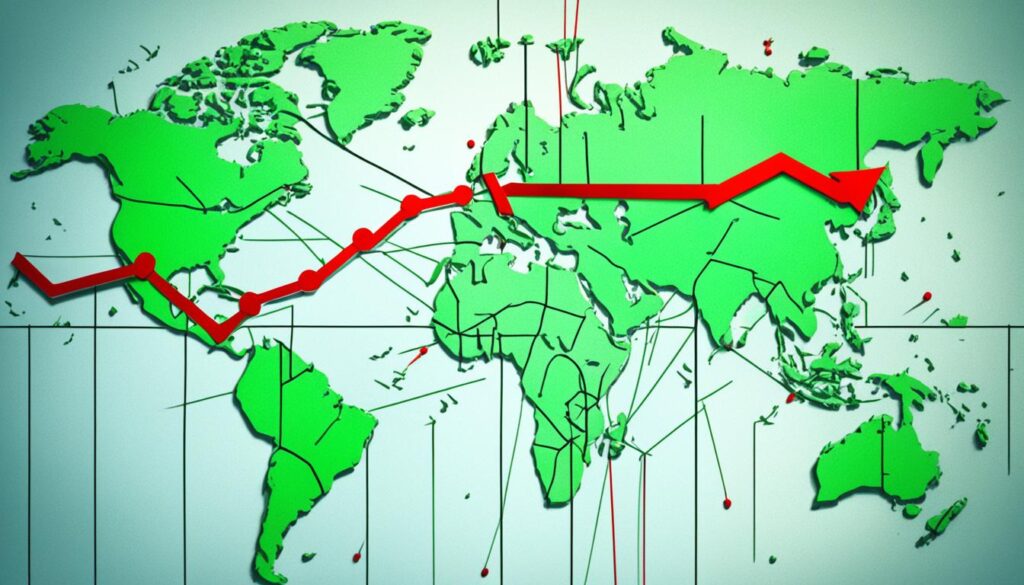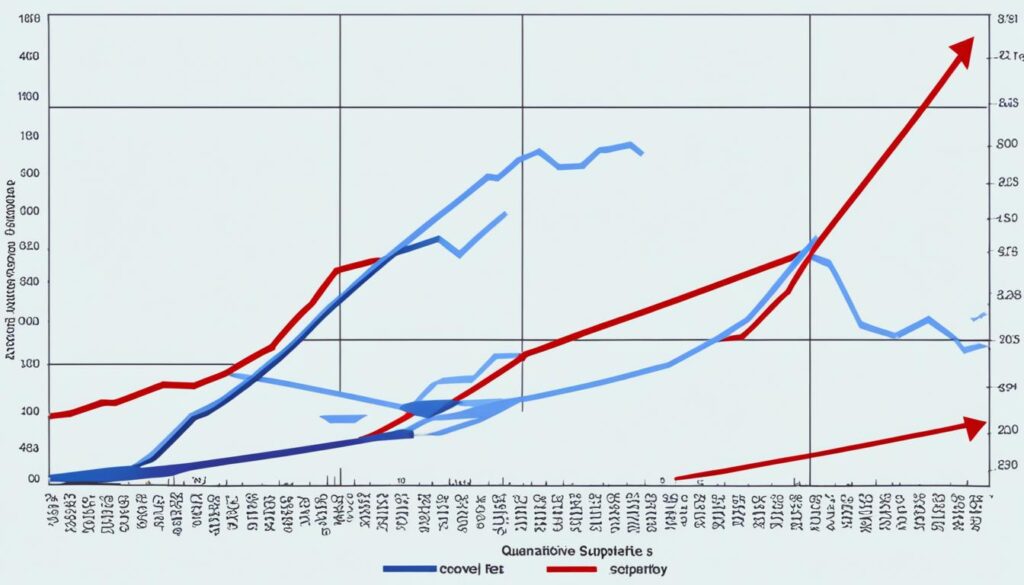“As an Amazon Associate I earn from qualifying purchases.”
In the wake of economic turmoil, an astounding 90% of governments worldwide have implemented some form of fiscal stimulus—with a surprising number now navigating the tightrope of recession growth strategies. You might wonder what makes these interventions by governments pivotal during such challenging times. As unemployment rates soar and investment wanes, it is these very recession growth strategies and fiscal policies that can ignite the engine of economic recovery.
Your understanding of how governments leverage economic stimulus and government interventions provides invaluable insight into the maze of macroeconomic management. Tailored monetary approaches and fiscal roadmaps chart the course for nations to not just survive but, intriguingly, to potentially thrive in the midst of revenue downturns and shrinking market demands. It’s through precise calibration of monetary policies and proactive responses that economies globally aim to forestall the long-term impacts of recessions.
Key Takeaways
- Understanding the importance of tailored fiscal policies in weathering recessions is key to appreciating government action.
- Exploring the breadth of monetary policies unveils the central banks’ roles in stimulating economic revival.
- Identifying effective recession growth strategies provides an overarching view of how economic downturns can be managed.
- Government interventions and how they pivot between inflation management and demand stimulation are essential learnings.
- Studying the impact of economic stimulus measures reveals the direct action governments take to support business expansion and bolster consumer confidence.
Understanding the Impact of Recessions on Economic Growth
Recessions are characterized by a significant decline in economic activity, which has far-reaching effects on various aspects of the economy. Recent events, such as the Russia-Ukraine conflict, have intensified these effects, leading to a profound economic downturn on a global scale. In this section, you will explore the ramifications of such downturns, focusing on the recession impact, unemployment rates, soaring inflation, and disruptions in global trade.
Inflation rates tend to rise during a recession due to a combination of factors including supply chain disruptions and higher resource costs. This inflation surge undermines purchasing power and suppresses consumer spending, which is a key driver of economic growth. Businesses face great challenges in managing production costs, which often lead to cutbacks and layoffs, further exacerbating the unemployment problem. Below is a detailed overview capturing the intricacies of these interrelated issues.

As businesses struggle to manage increased production costs amidst an economic downturn, the ripple effect of rising unemployment and declining consumer spending power becomes evident, further impeding economic growth.
| Indicator | Pre-Recession Levels | Current Levels | Change |
|---|---|---|---|
| Unemployment Rate | 3.5% | 6.0% | +2.5% |
| Inflation Rate | 1.8% | 5.4% | +3.6% |
| Consumer Spending | $13 Trillion | $11 Trillion | -15% |
| Global Trade Volume | $18 Trillion | $16 Trillion | -11% |
It is important for policymakers and businesses alike to understand and address these issues. Practical and strategic steps need to be implemented to mitigate the adverse effects of a recession. Such measures include but are not limited to, encouraging investment, sustaining consumer confidence, and fostering resilient trade partnerships to counteract the ongoing global trade challenges.
- Exploring alternative markets and diversified supply chains to buffer against global trade shocks.
- Introducing policies to stabilize employment and provide job security, aiming to curb the rise in unemployment.
- Implementing monetary policies that can help manage inflation without stifling economic growth.
By addressing unemployment head-on, carefully monitoring inflation rates, and ensuring the fluidity of global trade, economies can navigate through the turbulent waters of a recession and pave the way for a return to vigorous economic growth.
Monetary Policy Adjustments to Combat Recession Effects
As recessions unfold, central banks across the globe initiate a series of decisive steps to mitigate their impact on the economy. By manipulating monetary policy tools, they aim to stimulate activity, secure employment opportunities, and manage inflation. Understanding these central banking strategies is essential for grasping how macroeconomics function during turbulent times.

Reducing Interest Rates to Spur Investment
One of the primary measures taken by central banks is the strategic reduction of interest rates. Lower interest rates decrease the cost of borrowing, encouraging businesses and consumers alike to increase their loan intake for spending and investing. This can lead to a spurred economic activity, from real estate development to consumer purchases, which in turn has the potential to boost job creation and government tax revenues.
Quantitative Easing and Bond Purchases
Amidst economic contractions, quantitative easing (QE) becomes a focal point of central banks’ arsenal. Quantitative easing involves large-scale purchases of government securities, such as bonds, to inject money directly into the economy. By participating actively in the bond market, central banks aim to lower long-term interest rates, encourage lending, and increase investment and consumption.
| Year | QE Initiatives | Impact on Bond Yield |
|---|---|---|
| 2008 | Introduction of QE post-financial crisis | Significant decrease |
| 2012 | Operation Twist and QE3 | Moderate decrease |
| 2020 | Unprecedented QE in response to COVID-19 | Yields dropped to near-zero levels |
The Role of Inflation Management in Stimulating the Economy
An equally important strategy employed by central banks is inflation control. While moderate inflation can be desirable, indicating a growing economy, unchecked inflation can erode consumer purchasing power and create uncertainty. Central banks strive to keep inflation within their target range, thus preserving the value of the currency and the welfare of the citizens. These inflation control measures include adjusting interest rates and managing the money supply to ensure a stable economic environment conducive to sustainable growth.
During a recession, what is one way governments try to encourage growth?
When economic downturns strike, stimulus packages and tax incentives become essential tools in a government’s arsenal for spurring growth and facilitating economic recovery. Contrary to letting the market self-correct, proactive financial strategies are deployed to jumpstart the economy. Here’s how these stimuli work in tandem with other measures to counteract recessive trends.
To better understand the symbiosis between various stimulus initiatives, it’s useful to examine their intended effects and actual applications in the economic landscape. Note that while tax incentives can prompt immediate business investments, broader stimulus packages might have a wider range of benefits, including large-scale job creation and enhanced consumer spending.
| Stimulus Tool | Purpose | Expected Outcome |
|---|---|---|
| Tax Incentives for Businesses | To reduce operational costs and encourage expansion | Increased investment and job opportunities |
| Infrastructure Spending | To create jobs and improve long-term economic conditions | Boost in demand for construction and related sectors |
| Direct Consumer Spending | To enhance purchasing power and stimulate demand | Rise in overall consumption leading to production ramp-up |
“Strategic stimulus efforts have proven to be pivotal in revitalizing economies during recessionary periods. By carefully designing financial strategies, governments can lay the groundwork for robust economic recovery.”
As you navigate through an economic downturn, it’s important to understand how these measures can affect your personal finances and business. While stimulus packages may provide immediate relief, the long-term benefits derived from savvy financial planning activities, including taking advantage of various tax incentives, can sustain you through and beyond times of economic challenge.
Strategies for Public Spending and Debt Management
When economic downturns strike, governments are tasked with making strategic decisions to manage public finances effectively. This includes a comprehensive approach involving public expenditure, debt issuance, and intricate tax policies to buoy the economy without exacerbating the fiscal deficit.
Issuing Bonds to Raise Capital and Direct Spending
To defer the immediate impact of tax increases and to stimulate the economy, many countries resort to debt issuance, particularly by selling government bonds. This strategy not only attracts investment from within the nation but also from international investors, contributing to an inflow of capital that can be directed towards public projects and services.
Balancing Tax Increases with Growth Initiatives
Financing public services often requires a delicate balance in tax policies. An increase in taxes during a recession can be counterproductive, hindering both consumer spending and business investments. Thus, governments carefully design tax legislations to ensure revenue generation aligns with promoting sustainable growth, possibly through targeted tax cuts or credits.
Approaches to Debt Forgiveness and Economic Bailouts
In extreme situations where the debt burden becomes unsustainable, countries may consider options such as debt forgiveness or seek financial bailouts. These decisions, while complex, can provide a fresh start for economies on the brink, helping to restore international creditworthiness and allowing for a return to fiscal stability.
Collectively, these measures are essential in maintaining economic equilibrium. Whether it’s the careful structuring of tax policies, leveraging the bond market through debt issuance, or the strategic applications of debt forgiveness and financial bailouts, the main objective remains clear: to navigate through fiscal challenges while laying the groundwork for a resilient and prospering economy.
International Economic Coalitions’ Role in Alleviating Downturns
During times of economic hardship, global fiscal partnerships between countries can be a linchpin in stabilizing the tumultuous tides of a downturn. Foundations like the International Monetary Fund (IMF) and the World Bank, alongside consortiums such as BRICS, provide the scaffolding for beleaguered economies seeking to regain their footing. The synergy sourced from these economic alliances has historical precedence for setting the stage for recovery and growth in the global market.
IMF and World Bank: Financial Support and Policy Guidance
When you look towards influential global institutions for economic stability, the IMF’s emergency lending and the World Bank’s development-focused projects are at the forefront for offering IMF support and World Bank guidance to nations in crisis. Their concerted efforts provide not just financial aid but also advice on policy reforms needed to resuscitate struggling economies.
BRICS: Collaborative Strategies for Emerging Economies
The coalition of BRICS countries, encompassing Brazil, Russia, India, China, and South Africa, injects a unique dynamism into the landscape of global economics. Their BRICS initiatives advocate for equitable representation and promote trade and investment opportunities among emerging markets and developing nations.
Assessing the Effectiveness of Global Economic Partnerships
Assessment of these coalitions’ effectiveness is an exercise in examining their ability to galvanize collective action and to foster economic security. The strength of global fiscal partnerships can often be observed in their response to crises, much like the solidarity shown in the 2008 financial meltdown.
| Organization | Type of Assistance | Impact |
|---|---|---|
| IMF | Emergency Lending | Short-term financial stability, currency support |
| World Bank | Development Projects | Sustainable growth, infrastructure development |
| BRICS New Development Bank | Loans for Infrastructure and Sustainable Development | Long-term investment in member countries, strengthening South-South cooperation |
In concluding, the robust collaboration between countries under the umbrella of economic alliances such as the IMF, World Bank, and BRICS initiatives plays an indispensable role in weathering the effects of economic downturns. With a focus on IMF support, World Bank guidance, and BRICS initiatives, these entities exemplify the strength found in unity and the ability of global fiscal partnerships to lay a path forward from financial adversity to prosperity.
Conclusion
In the complex dance of global economics, your government stands at the forefront, choreographing moves that can steer your country away from the brink of a recession. The sharp edge of recession recovery lies in wielding proactive fiscal management and strategic economic planning. Such initiatives are designed not only to revitalize faltering markets but also to instill economic resilience in the face of adversity. As a citizen, it’s essential to recognize both the efforts and the multifaceted strategies employed to fight inflation and stimulate growth.
Calling upon a blend of monetary finesse and fiscal discipline, policymakers are tasked with controlling costs and incentivizing a spectrum of investments to foster a diverse and robust economic environment. As you observe these processes, it’s clear that there is no singular magic spell to dispel the rigors of an economic downturn. Rather, it is about the subtle art of implementing policies that support the overall economy and encourage demand among consumers and investors alike.
This delicate balance between intervention and support holds the key to not just surviving a recession, but flourishing in its aftermath. Your government’s judicious approach can pave the road to recovery, laying firm foundations for a future where your economy doesn’t just bounce back, but leaps forward. And while the journey to sustainable economic recovery may be fraught with challenges, know that with the right strategies in place, your nation can navigate its way towards a steadier, more prosperous horizon.
FAQ
What are some recession growth strategies that governments use to stimulate the economy?
How do economic downturns impact global trade and unemployment?
What monetary policies do central banks implement to mitigate the effects of a recession?
How does quantitative easing help during a recession?
What is the role of inflation management in a recession?
How do stimulus packages encourage economic growth during a recession?
What measures are involved in public spending and debt management strategies?
How do international coalitions like the IMF and World Bank assist countries during economic downturns?
What is the role of BRICS in managing global economic downturns?
Can debt issuance and fiscal bailouts effectively address recession-related economic challenges?
Source Links
- https://www.rba.gov.au/education/resources/explainers/recession.html
- https://www.whitehouse.gov/wp-content/uploads/2022/12/TTC-EC-CEA-AI-Report-12052022-1.pdf
- https://www.forbes.com/advisor/investing/what-is-a-recession/
- https://www.whitehouse.gov/cea/written-materials/2022/07/21/how-do-economists-determine-whether-the-economy-is-in-a-recession/
- https://www.businessinsider.com/personal-finance/recession-vs-depression
- https://www.mckinsey.com/featured-insights/mckinsey-explainers/what-is-a-recession
- https://www.investopedia.com/terms/d/demandshock.asp
- https://en.wikipedia.org/wiki/Recession
- https://www.mckinsey.com/capabilities/risk-and-resilience/our-insights/somethings-coming-how-us-companies-can-build-resilience-survive-a-downturn-and-thrive-in-the-next-cycle
“As an Amazon Associate I earn from qualifying purchases.”

